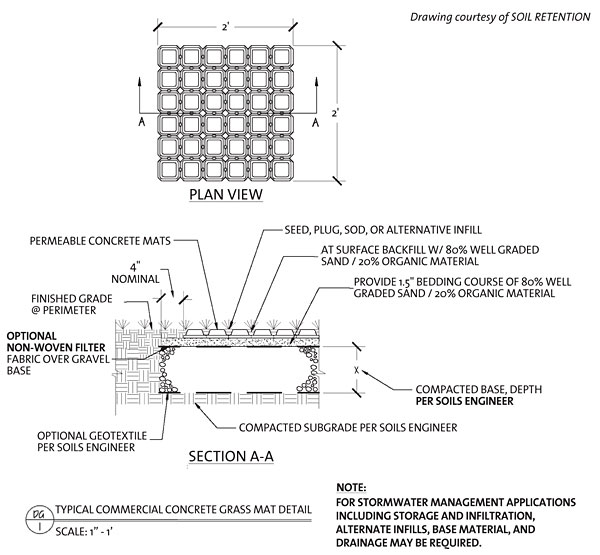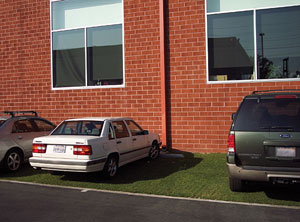Strategies for More Sustainable Exterior Solutions
STRATEGY #2: MEASURE 6: Water Cycle
Sustainable design conserves water and protects and improves
water quality.
The Horizontal Plane −designing for living habitats and water conservation
Low growing oregano, marjoram and thyme, bring fragrance when grown in a permeable, flexible and plantable concrete paving system. Using permeable, flexible, planted paving systems provides an opportunity to recharge the local aquifers, the source of drinking water in all areas of the country. These systems can assist with federal requirements for storm water management, reduce heat island effects, and in some communities, increase the proposed building footprint based on additional detention and infiltration areas per city ordinances and codes.
 |
A section of a typical planted cement paving system Drawing courtesy of SOIL RETENTION |
Â
Most plantable concrete paving systems are cellular. One of the newest products is made from pre-cast concrete, cast around a flexible mesh. Installed correctly, this system will provide a living horizontal plane in a surface that will provide stormwater management as well as an innovative green parking garden. Plantable concrete paving systems provide an opportunity for the continuation of connecting living habitats across a site's infrastructure.
These systems can be as thin as one and one half inches thick, and be laid as a two foot by two foot precast concrete mat. The surface below the mat is prepared with a base of crushed rock, between three and four inches for residential applications and up to 12 inches for commercial projects. Over the aggregate a structured soil or root zone is placed, comprised of 80 percent sand and 20 percent organic materials. The mat is set over this engineered soil surface in grids that are fitted and aligned together. Because the mat layer is thin and set on top of the root zone, the plantings share irrigation moisture between all of the cells. In contrast, many individual cellular pavers are deeper and tend to constrict proper irrigation moisture from transferring cell to cell. In the Construction Specification Institute Master spec Section 32 12 43 (1997 Section 02795), permeable, plantable paving systems have their own category and performance standards.
The flexible concrete paving system is designed to expand and contract with the freeze thaw cycle, has low moisture content, and can be specified in numerous colors to match the designer's palette. Beside fragrant herbs, landscape designers can specify other low growing plants, silvery grasses, new hybrid drought tolerant buffalo grass or even just an aggregate or bark infill. After planting, the horizontal surface can be mowed as it grows or in snowy climates, with proper height adjustments can be scraped by snow plows with teflon runners and squeegee blades. In icy weather, planted driveways provide, safe walkways as the concrete warmed by the sun, transfers heat through the soil providing ice melt that infiltrates into the ground below instead of ponding.
 |
Plantable paving met city ordinances and for LEED® requirements as well as provided additional green parking for the Red Bull headquarters in Santa Monica, California. Photo courtesy of SOIL RETENTION |
The new Red Bull headquarters in Santa Monica, California, designed for LEED® platinum, by architect Yi Shen with HLW International, used permeable paving for storm management.
Plantable concrete paving systems can assist with LEED® credits in numerous ways. In site development categories, they protect and restore habitats, maximize open space and provide stormwater design credits for quality and erosion control. They assist with the reduction of heat island effects for non-roof categories and some systems can also be used for green roofs. These paving systems can be used as a permeable water filter that can collect water for re-use, and planted with water efficient landscaping for more water savings on the site. They can contribute to an innovation credit as part of an integrated strategy for design and site planning.
Tests have been performed on these systems that show that they maintain their stability, even under the weight of large vehicles, providing proof for city fire departments that this product meets requirements for deflection standards. This product should be installed as a system. A common mistake is to believe that the substructure is not needed in order to grow a paved field of grass. These concrete mats can have up to 45 percent replacement of portland cement with fly ash, providing assistance with LEED® V3 credits for the highest levels of post-consumer recycled content. Many of these systems are manufactured throughout the United Sates and can also assist with credits for regional materials.
As an added bonus, planted concrete paving systems are easy to install and can increase buildable footprints by reducing detention requirements. Last year, six or seven church volunteers in Florida installed over 5,000 sf of pavers a day for their new planted driveway area. Local planning and building departments are requiring more stormwater onsite retention to comply with the federal National Pollutant Discharge Elimination System (NPDESII) statute. In response, architects and owners are providing alternative parking areas that also double as infiltration basins.
Planted concrete paving systems provide professionals with many opportunities for LEED® credits including those for site development, stormwater design, heat island effect, water efficient landscaping and recycled content not to mention the many ways to design with these systems for innovation credits. Professionals and homeowners are planting natural areas in constructed parking lots and driveways to increase green space. Installing planted driveway paving systems can contribute to the reduction of the heat island effect in urban areas, create more opportunities for storm water detention, and help the environment with an ecological alternative to solid asphalt or concrete paving.









